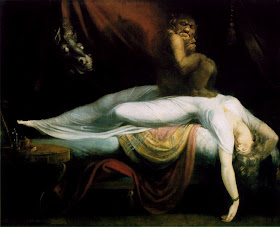7th November 2004
Before I first saw this I already knew that there was a reference to Immendorff’s famous Hört auf zu Malen (Stop Painting, 1966); the Expressionist work that called for painting to cease unless it was motivated by political commitment, but I had no idea what the title signified. I have since read in Frieze magazine[1] that the title fuses the Gideon bible (Gideon was the poor farmer who became the saviour of the Israelites through sheer faith in God) with Marvin Gaye’s sensual ‘Let’s Get It On’ (1973) - and with Armageddon.

The canvas is very thick and rough, almost like hessian and the brushwork is very loose and expressionistic. There are some thick lumps of paint contrasting with thin dribbles and splashes.
On this surface Richter establishes his own grid with the patterned wall of a supermarket or shopping centre, its windows and the paved plaza in front. Pedestrians outside this supermarket gaze open-mouthed at the sky, frozen in time as they move towards an unseen vision. A dog is reluctantly dragged forwards, it’s as if he knows better and wants to keep well away. In the background one couple start a fight; another have stripped naked and are painting the windows of the shop with Kandinsky like washes. One little girl stares out at the viewer and a little chap in a Napoleon hat hovers above the crowd.

According to the Frieze article, these two protagonists are ‘direct quotes from works by Vasily Surikow, the 19th-century Russian painter who mixed genre and history painting in an attempt to be understood by ‘ordinary’ people’[2]. I have found the paintings he is quoting from, the latter is from The Morning of the Execution of the Streltsy, 1881 and the girl is from Portrait of the Artist's Daughter, 1888. Her strong colour contrast with the rest of the scenario draws the eye and her returning gaze, the only one towards the viewer, unsettles in a similar way to the non-plussed stare of the Grady sisters in Stanley Kubrick’s “The Shining”. However, I am no closer to understanding their significance in the painting, nor why he has injected these realistic quotations into the astonished crowd. Are they placed as commentators or judges on the theatre unfolding on the canvas?
I certainly don’t find the painting as melancholic as some of his later work, but the figures frozen in a shimmering light is unsettling and suggests the nuclear threat that seemed so real in the 1960’s. The fact that this light might be “The End” is reinforced by the title and by the sixth sense of the dog shying away from the blue glow.
[1] Frieze Issue 74 April 2003
[2] Frieze Issue 74 April 2003
©blackdog 2009






